Speed Up Your DevOps Path: Advancing Automation and Novelty
 Vidhi Chhabra
Vidhi Chhabra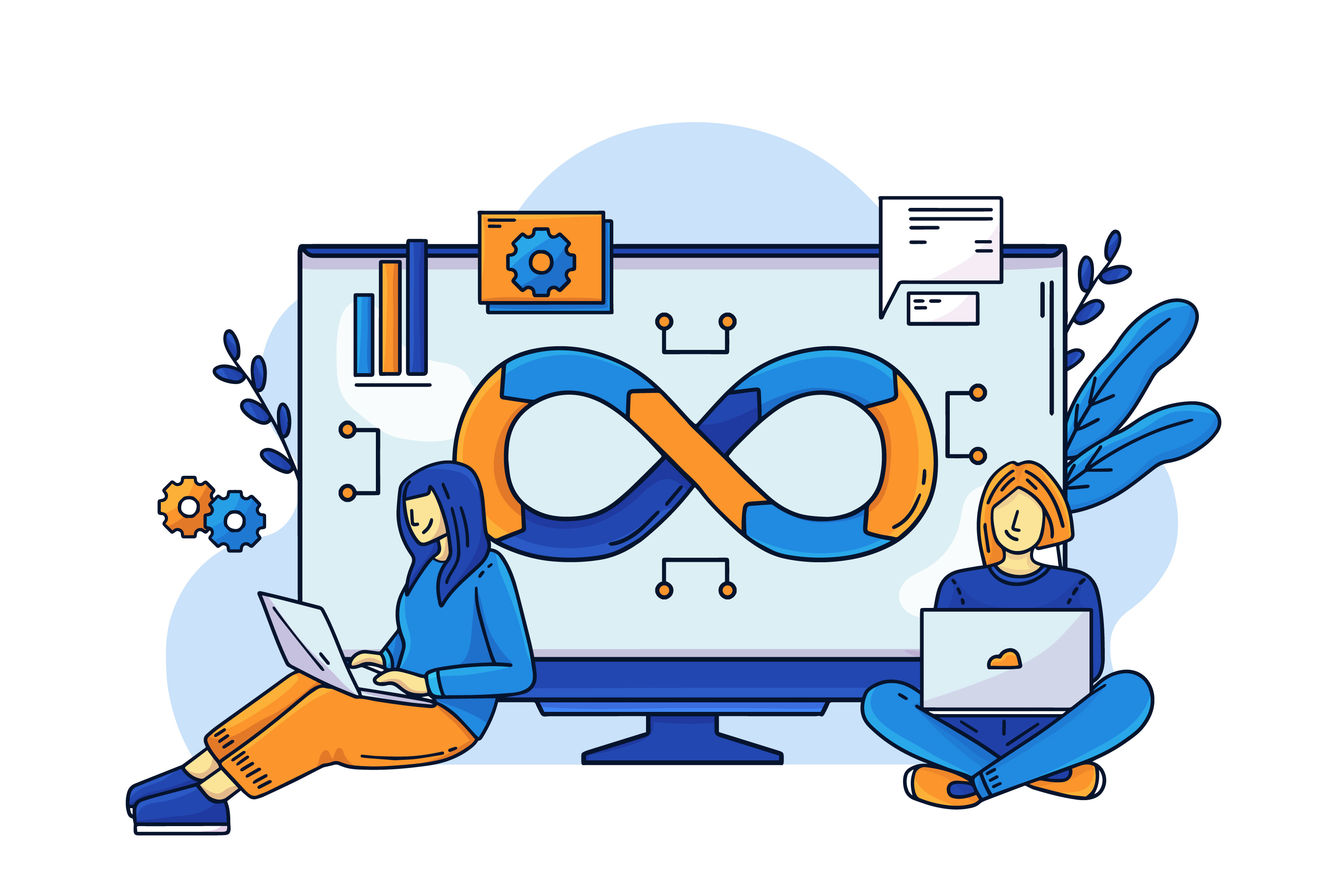
"Welcome to my DevOps Corner, fellow explorers!"
Thank you for joining me on this journey into the heart of DevOps. In today's blog, we'll unravel the mysteries behind this transformative buzzword, delving into the basics and discovering the wonders it brings to the tech world. I'm excited to share valuable insights and knowledge, so let's embark on this adventure together.
"Happy reading, and let's dive into the fascinating realm of DevOps on our first day!"
What is DevOps:
You've probably come across the following definitions when searching for the meaning of DevOps:
DevOps is not a technology; it's a methodology or a set of practices and cultural philosophies.
The term is a combination of two words: Development and Operations.
DevOps is more about the collaboration and communication between development (Dev) and operations (Ops) teams, with the goal of improving and automating the software delivery and infrastructure management processes.
It's a mindset and a set of principles that guide how teams work together to deliver software efficiently and reliably.
Let's begin by exploring the evolution of DevOps from its inception to better understand these definitions.
The Evolution of DevOps: Bridging the Gap Between Waterfall and Agile
It all began with the traditional form of software development known as the waterfall approach.
Waterfall model:
In a waterfall, once the water has flowed over the edge of the cliff, it cannot turn back. The same principle applies to the waterfall development strategy, where an application can only proceed to the next stage when the previous stage is complete.
Now, let's examine the various stages involved in the waterfall methodology.
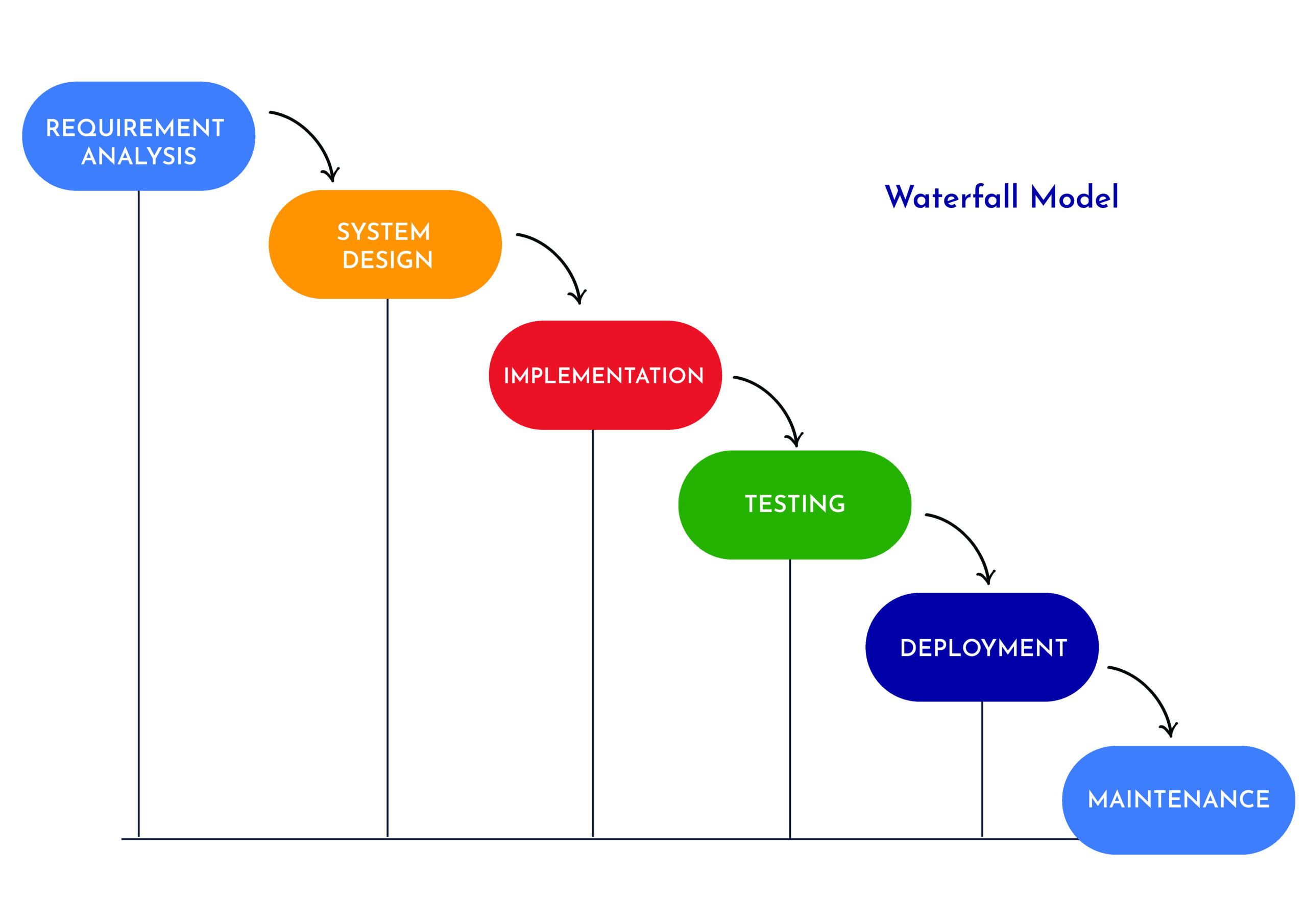
You can also visualize it as a ladder, where the first step is:
The client provides requirements for an application. You gather these requirements and analyze them to determine the application's design and appearance.
Next, you begin writing the code for the application and build it. This process includes compiling the application, unit testing, and packaging.
Afterward, the application is deployed onto test servers for testing and then onto production servers for release.
Once the application is live, it is monitored.
Advantages of Waterfall model:
es:Clear Project Phas
- The Waterfall model is characterized by well-defined and distinct phases (Requirements, Design, Implementation, Testing, Deployment, Maintenance). This clarity helps in project planning and execution.
Simple and Easy to Understand:
- The linear nature of the Waterfall model makes it straightforward and easy to understand, making it suitable for projects with relatively simple and well-understood requirements.
Stable Requirements:
- If project requirements are stable and unlikely to change significantly, the Waterfall model can be effective. It is less suited for projects with evolving or unclear requirements.
Comprehensive Documentation:
- Each phase in the Waterfall model generates detailed documentation, providing a comprehensive record of the project. This documentation can be beneficial for maintenance and future reference.
Well-Suited for Small Projects:
- Waterfall can be suitable for small projects with clear, predefined objectives and minimal complexity. The sequential nature simplifies project management for smaller teams.
Easier to Manage:
- The linear progression of phases makes project management and tracking progress relatively straightforward. Each phase has specific deliverables and milestones.
Limitations of the Waterfall Model:
Code Modification Challenges:
- Once in the testing stage, it's difficult to go back and make changes to code, leading to potential challenges in fixing bugs or addressing issues that were not well thought out in the concept stage.
High Risk and Uncertainty:
- There's a high level of risk and uncertainty, especially after the product is live. Any bug or downtime requires revisiting the entire source code and going through the lengthy Waterfall process to produce a working software again.
Complex Rollback Procedures:
- Upgrading software in the production environment can lead to failures, and rolling back to a previous stable version is a time-consuming process.
Incompatibility with Changing Requirements:
- The Waterfall model is not well-suited for complex and object-oriented projects, nor is it appropriate for projects where requirements have a moderate to high risk of changing. To illustrate this, imagine your client provides you with requirements for a web application today. You take your time and plan to release the application in one year. However, after one year, the market has shifted, and the client no longer wants a web application but instead seeks a mobile application. In such cases, the Waterfall model is not suitable due to its inflexibility with changing requirements.
Challenges of the Waterfall Model:
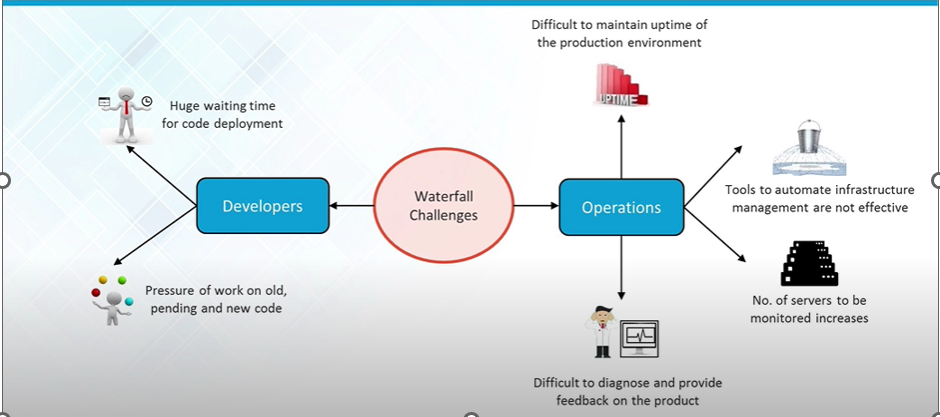
Huge Waiting Time for Code Deployment:
- Code deployment occurs late in the Waterfall model, leading to a significant waiting time before stakeholders can see the results. This delay can hinder feedback and responsiveness to changing requirements.
Pressure of Work on Old Pending and New Code:
- Work accumulates as each phase is completed sequentially. The pressure arises from managing both pending old code and incorporating new code simultaneously, creating challenges in workload management.
Difficult to Maintain Uptime of the Production Environment:
- Maintenance and updates in the Waterfall model may disrupt the production environment, and ensuring continuous uptime becomes challenging. This can impact the reliability and availability of the system.
Tools to Automate Infrastructure Management are not Effective:
- Waterfall may not integrate well with modern automation tools, making infrastructure management less efficient. This lack of automation can lead to manual errors and slow response times.
Number of Servers to be Monitored Increases:
- The progression through different stages in Waterfall can result in an increasing number of servers to be monitored. This poses a challenge in terms of resource-intensive monitoring efforts and scalability.
Difficult to Diagnose and Provide Feedback on the Product:
- Late-stage testing and feedback cycles in Waterfall make it difficult to diagnose and address issues effectively. This delay can impact the overall quality of the product and hinder responsiveness to user feedback.
What needs to be done:
Addressing these challenges requires a shift towards more agile and DevOps-oriented practices.
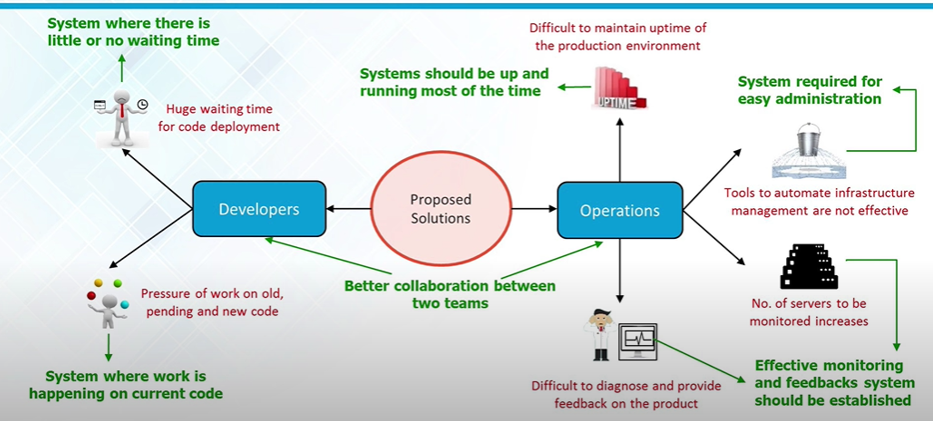
This is where agile came into being!
In the waterfall method, a single, straight-line workflow made it impossible to include client feedback and make changes.
Waterfall doesn't support what software development excels at: evolving, changing, updating, optimizing, improving, and extending. As a result, developers and businesses began searching for a better way to build and deploy software projects, seeking a more flexible, faster, responsive, and agile approach.
Agile Methodology:
Agile software development breaks the product into small pieces and later integrates them for the final test. This approach aims to bridge the gap between developers and stakeholders, allowing the agile team to meet customer needs and expectations, even in real-time.
Now, let's delve into the true story of how agile emerged at the forefront...
In 2001, seventeen software engineering experts, including Martin Fowler, Robert Martin, Dave Thomas, and Kent Beck, gathered at a ski resort in Utah. They documented the methods they had been using alongside traditional development processes, resulting in the creation of the Agile Manifesto. The Agile Manifesto consists of 12 principles and 4 values.
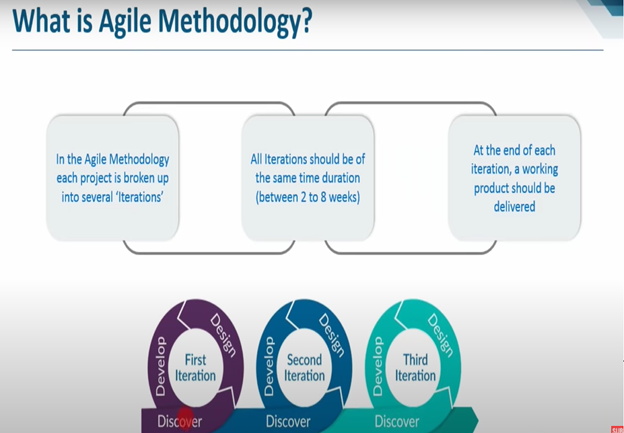
Agile practice promotes continuous iteration of development and testing throughout the software development life cycle of the project.
With the agile methodology, development and testing of an application occur continuously.
We receive feedback from the testing done in the previous iteration. We redesign the application, develop it, test it again, and discover new elements that can be incorporated into the application.
The process involves multiple iterations of designing, developing, and testing a particular application.
Waterfall vs. Agile
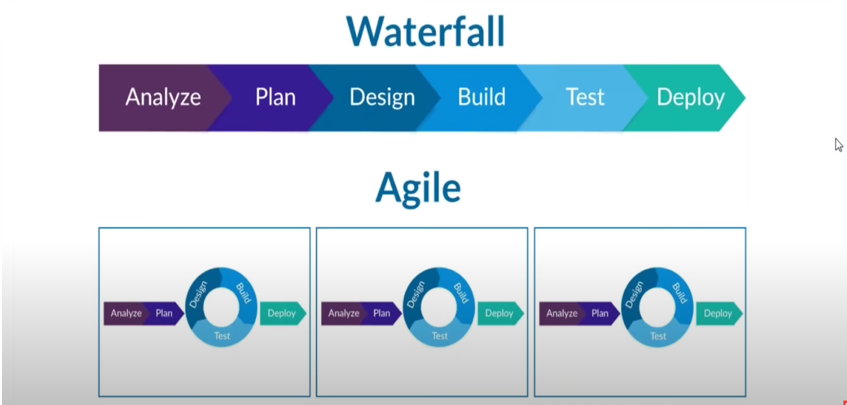
The waterfall model is quite linear and straightforward, as can be seen from the diagram. We analyze requirements, plan, design, build, test, and finally deploy the application onto the production servers for release. However, with the agile methodology, the design, build, and testing phases occur continuously.
We write the code, build the application, and test it continuously, with several iterations involved in this particular stage. Once the final testing is complete, it is then deployed onto the production servers for release.
The agile methodology essentially breaks down the entire software delivery life cycle into small sprints or iterations, allowing the development and testing parts of the software delivery lifecycle to happen continuously.
When discussing the waterfall model, it is suitable for projects where requirements have a low to moderate risk of changing, meaning the requirements are relatively static. On the other hand, when considering agile methodology, if your application has a moderate risk of changing, then using agile is also a viable option.
Benefits of the Agile Model:
Faster Time-to-Market:
- Agile's iterative approach facilitates shorter development cycles, leading to faster delivery of product increments and quicker time-to-market.
Improved Collaboration:
- Agile promotes close collaboration among cross-functional teams, enhancing communication and understanding between developers, testers, and stakeholders.
Enhanced Customer Satisfaction:
- Regular feedback and continuous delivery result in products that better meet customer expectations, leading to higher satisfaction levels.
Better Risk Management:
- Agile's iterative cycles enable early detection and mitigation of risks, reducing the likelihood of major setbacks during the development process.
Increased Employee Engagement:
- Empowering teams to make decisions and take ownership of their work fosters a sense of accountability and engagement among team members.
Adaptive to Changes in Requirements:
- Agile welcomes changes in requirements, making it easier to adapt to evolving business needs without causing significant disruptions.
Increased Productivity:
- Agile's focus on delivering small, incremental releases encourages a steady and sustainable pace of work, contributing to increased team productivity.
Agile enhances team collaboration, speeds up product delivery time, increases predictability, reduces risks, and even bridges the gap between developers and clients.
However, the developers' group was still unsatisfied!
There was immense pressure on the developers to perfect the code, and system administrators had little to no time to contribute to the entire process.
While communication improved with the stakeholders on one end, the internal communication between developers and operations teams was not streamlined. This caused internal issues that somehow slowed down the process, despite improving the entire software development process.
And then, the game-changer arrived – DevOps…
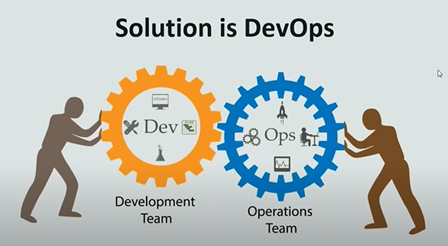
Agile dominated the software development industry for 7 years until 2008, when Andrew Clay and Patrick Debois collaborated to address the gaps in the modern agile process. Agile wasn't problematic, but incomplete. Engineers needed more to bridge communication gaps between departments and speed up collaboration and product delivery.
DevOps was the solution to bridge the productivity gap between the developers and the operations teams. It took only one event in Belgium in 2009 to bring the world to a new recognition that DevOps was the new titan in the software engineering industry.
Why Do We Need DevOps?
Let's use a real-life analogy to explain DevOps:
Scenario-1: Imagine Building and Running a Restaurant:
Traditional Approach (No DevOps):
- In the traditional way, building a restaurant is like a relay race. The architects design the building, then pass the plans to builders, who pass it to decorators, and so on. Each team works separately, often leading to miscommunication, delays, and a potential mess. You might end up with a beautiful building, but it takes a long time, and the process can be chaotic.
DevOps Approach (With DevOps):
Now, think of a restaurant with a DevOps approach. It's like having a well-coordinated kitchen where chefs, waitstaff, and managers work hand-in-hand. The chefs (developers) prepare the dishes, the waitstaff (operations) serve them, and the managers ensure everything runs smoothly. They communicate constantly, making sure the food is delicious, the service is fast, and the customers are happy.
If a customer requests a new dish (feature), the chefs immediately start working on it, and the waitstaff seamlessly introduces it to the menu. The whole process is fast, efficient, and everyone collaborates to make the dining experience great.
Key Takeaways:
Efficiency: DevOps ensures all parts of the process work together smoothly, like a well-run kitchen.
Communication: Teams (chefs, waitstaff) constantly communicate, avoiding misunderstandings and delays.
Customer Satisfaction: The focus is on delivering a great experience for the customers (users).
Adaptability: If the restaurant needs to change its menu or add new items, it can do so quickly without disrupting the entire operation.
So, in the world of technology, DevOps is like the secret sauce that makes everything run smoothly, ensuring fast and high-quality service for users, just like a well-managed restaurant.
Certainly! Let's use a real-life example to illustrate DevOps in the context of software development within an organization:
Scenario-2: Building and Updating a Mobile App
Traditional Software Development (Without DevOps):
Imagine a scenario where a mobile app development team works separately from the operations team responsible for deploying and maintaining the app. Developers design and code new features in isolation, and once the features are ready, they hand over the code to the operations team for deployment.
When deploying the new version of the app, the operations team faces challenges like compatibility issues, unexpected bugs, and delays in the deployment process. Communication gaps between teams can result in misunderstandings, and fixing issues requires back-and-forth communication, leading to slower release cycles.
DevOps in Software Development (With DevOps):
Now, consider the same organization adopting DevOps practices. The development and operations teams collaborate closely from the start. Developers work on coding new features, automated testing tools check the code for issues, and the operations team ensures that the deployment process is streamlined.
Continuous Integration (CI) tools automatically merge and test new code changes. Continuous Deployment (CD) pipelines automatically deploy the app to various environments, ensuring consistency. If there's a bug or a need for a change, the process is agile, and updates are rolled out seamlessly.
Key Takeaways:
Collaborative Development: DevOps fosters collaboration between developers and operations, breaking down silos and improving communication.
Automated Testing: Continuous Integration tools automatically test code changes, catching issues early in the development process.
Efficient Deployment: Continuous Deployment pipelines automate the deployment process, reducing the likelihood of errors during release.
Rapid Adaptation: If there's a need to fix a bug or update a feature, the organization can do so quickly and efficiently, maintaining a responsive and adaptive software development cycle.
Outcome: By adopting DevOps practices, the organization achieves faster, more reliable software development. The mobile app evolves continuously, delivering new features and updates seamlessly, ultimately providing a better experience for users while maintaining operational efficiency.
Comparing Waterfall, Agile, and DevOps using real-life examples:
Let's simplify the comparison using the restaurant analogy:
Scenario 1 : Restaurant Transformation
Once upon a time, there was a restaurant that decided to revamp its entire dining experience. Here's how they approached it using Waterfall, Agile, and DevOps:
1. Waterfall Era:
Scenario: The restaurant planned a grand reopening with a fixed menu. They meticulously designed every detail, from the dishes to the décor.
Outcome: The grand reopening took a long time. The menu was beautiful, but the rigid plan led to delays, and by the time they opened, some trends had changed.
2. Agile Transition:
Scenario: Learning from the first experience, the restaurant embraced a more flexible approach. They decided to change the menu seasonally, adapting to customer preferences.
Outcome: The restaurant could make adjustments quickly. If a dish wasn't popular, they could replace it with something new. Customers loved the variety, and the restaurant stayed in tune with trends.
3. DevOps Revolution:
Scenario: Wanting to take it a step further, the restaurant introduced an open kitchen where chefs, waitstaff, and managers collaborated seamlessly.
Outcome: When a customer suggested a unique dish, the chefs immediately started preparing it. The waitstaff smoothly introduced it to the menu. The whole process became a continuous, collaborative effort, resulting in a dynamic and customer-centric dining experience.
In Summary:
Waterfall: Like planning a fixed menu for a grand reopening, leading to delays.
Agile: Adapting to changing tastes by updating the menu seasonally, staying flexible.
DevOps: Creating a collaborative open kitchen where everyone works together for immediate changes, ensuring a delightful dining experience that evolves with customer preferences.
This real-life story simplifies DevOps, Waterfall, and Agile by using the analogy of a restaurant's transformation, making it relatable and easy to understand.
Scenario 2 : Building a Website
Imagine a team tasked with building a website for a growing business. Let's see how they approached it using DevOps, Waterfall, and Agile:
1. Waterfall Approach:
Scenario: The team followed a traditional plan. They spent months gathering requirements, designing the entire website, coding, testing, and finally deploying it.
Outcome: The website was comprehensive, but it took a long time to launch. Changes were cumbersome, and by the time it went live, some features were already outdated.
2. Agile Approach:
Scenario: Learning from the Waterfall experience, the team decided to take an Agile approach. They released a basic version of the website quickly, focusing on core features like homepage, product pages, and contact forms.
Outcome: The initial website went live within weeks. Users could interact with it, providing valuable feedback. The team then continuously updated the site, adding features based on user needs and preferences.
3. DevOps Approach:
Scenario: Seeking to optimize collaboration and deployment, the team embraced DevOps practices. They automated testing, integration, and deployment processes to ensure a seamless and continuous delivery pipeline.
Outcome: Changes, updates, and new features were implemented swiftly. The website evolved with user feedback in real-time. The collaboration between development and operations ensured a stable and reliable online presence.
In Summary:
Waterfall: Lengthy planning and development process with a comprehensive, but slow, website launch.
Agile: Quick release of a basic website, followed by continuous updates based on user feedback.
DevOps: Seamless collaboration and automated processes, resulting in swift and continuous website evolution.
Agile vs. DevOps:
Agile and DevOps have always been referred to as interrelated concepts, but how are these two methodologies distinct?
So, what can we understand from these two terms? Are they connected? Are they different? Or do they just support each other? Let's discover.
To answer these questions – yes, DevOps and Agile can be interconnected. Statistical evidence suggests that among the companies and organizations that have adopted DevOps, 63% have experienced continuous improvement in the product development process.
Additionally, 94% of organizations practice agile. Given these statistics, I firmly believe that a cultural shift is worth the risk if it leads to enhanced organizational output and application performance.
How do Agile and DevOps interrelate?
Going back to the basics of Agile and DevOps methodology, it is clear that Agile laid the foundation for DevOps. This is because Agile focuses on the flow of software from ideation to code creation, while DevOps takes it up a notch and extends the approach to delivery and maintenance.
Interestingly, if organizations were to realize the complete implementation and benefits of Agile, then they need to implement DevOps.
Let me tell you how…
The 17 software engineering experts of the Agile Manifesto established the 12 Principles of Agile methodology, which emphasize continuous integration, delivery, and frequent release cycles. To fully realize these core values, the implementation of DevOps practices is necessary.
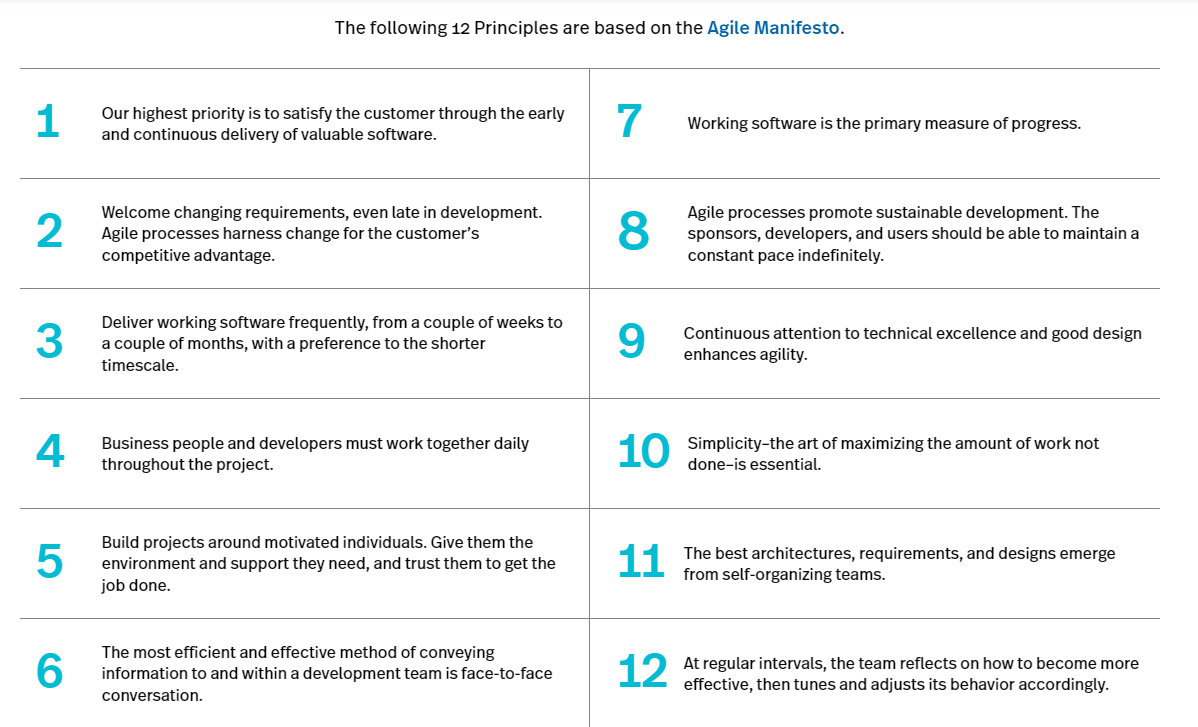
Yes, DevOps and Agile are highly interrelated and often complement each other in the software development and IT industry. Both DevOps and Agile methodologies aim to improve the efficiency, collaboration, and delivery of software. Here's how they are connected:
Common Goals:
- Both DevOps and Agile share common goals such as delivering high-quality software, responding to change quickly, and enhancing customer satisfaction.
Collaboration:
- Agile emphasizes collaboration among cross-functional teams, including developers, testers, and business stakeholders. DevOps extends this collaboration by fostering cooperation between development and operations teams, breaking down silos for more efficient communication and teamwork.
Iterative and Incremental Development:
- Agile practices, including Scrum and Kanban, promote iterative and incremental development. DevOps complements this by ensuring that the continuous integration and continuous delivery (CI/CD) pipelines enable frequent and reliable releases.
Customer-Centric Approach:
- Both methodologies prioritize delivering value to customers. Agile achieves this through iterative releases, and DevOps ensures a smooth and continuous delivery pipeline, reducing time to market.
Adaptability to Change:
- Agile methodologies embrace changing requirements even late in the development process. DevOps supports this adaptability by automating processes and providing a flexible infrastructure that can quickly respond to changes.
Feedback Loops:
- Both DevOps and Agile emphasize the importance of feedback loops. Agile uses regular sprint reviews and retrospectives, while DevOps leverages feedback from operations to development and vice versa, ensuring continuous improvement.
Continuous Integration and Continuous Delivery (CI/CD):
- Agile practices benefit from CI/CD pipelines that DevOps promotes. This ensures that code changes are integrated and tested continuously, leading to more stable and reliable software releases.
Cross-Functional Teams:
- Agile encourages the formation of cross-functional teams with members possessing various skills. DevOps extends this concept by promoting collaboration between not only development and testing but also operations and other relevant stakeholders.
Automation:
- Both Agile and DevOps leverage automation to streamline processes. Agile uses automation in testing and deployment, while DevOps extends automation across the entire software delivery pipeline, from development through operations.
While Agile focuses on the development process and collaboration within development teams, DevOps extends these principles to include operations, aiming for a holistic and integrated approach to software delivery. Organizations often find that implementing both Agile and DevOps practices creates a powerful combination for delivering software efficiently and with high quality.
In Summary:
DevOps: Encompasses collaboration and automation across the entire software delivery lifecycle, including operations.
Agile: Primarily focuses on iterative development, customer feedback, and adaptability within the development phase.
While DevOps and Agile share some principles, they differ in their scope, focus, and the stages of the software development lifecycle they address.
The ultimate goal of both Agile and DevOps is to foster collaboration between different departments, achieve scalability, amplify the feedback loop, release products quickly, and enhance business productivity.
Your smartphone automatically updating an app is an example of agile and DevOps practices. A team has finished a sprint, and they've used automated unit testing and continuous delivery to automatically send out the update.
When looking at the bigger picture, organizations can rely on both DevOps and Agile methodologies to achieve their software development objectives and obtain higher returns on their investments.
How can DevOps help with Agile challenges?
Let's explore some disadvantages of the Agile model and how implementing DevOps can address these challenges:
Lack of Alignment Between Dev and Ops Teams:
Agile can cause development and operations teams to be out of sync. DevOps, on the other hand, encourages teamwork and shared responsibilities, ensuring smooth collaboration between the two groups.
Inconsistencies in Development and Production Environments:
Problem (Agile): Code inconsistencies between development and production environments can cause conflicts between teams.
Solution (DevOps): DevOps uses consistent, automated deployment practices like Infrastructure as Code (IaC) to align development, testing, and production environments, minimizing discrepancies.
Balancing Agility and Stability:
Problem (Agile): Conflicts between development and operations teams due to differing priorities of agility and stability.
Solution (DevOps): Balancing agility and stability through Continuous Integration (CI) and Continuous Deployment (CD) for quick, reliable releases and a stable production environment..
Resistance to Change and Cultural Shift:
Problem (Agile): Resistance to adopting Agile due to traditional methods, making cultural change difficult.
Solution (DevOps): DevOps promotes a culture of teamwork, communication, and ongoing improvement, helping organizations overcome resistance and create a more flexible and cooperative environment.
Lack of End-to-End Visibility:
Problem (Agile): Incomplete visibility of the process can lead to difficulties in identifying and resolving issues, causing delays.
Solution (DevOps): DevOps emphasizes monitoring and logging for a clear view of the development and deployment pipeline, enabling teams to address problems efficiently.
Real-Life Example: Building a Software Product
Agile Approach: In Agile software development, projects are divided into small increments called sprints, each lasting about two weeks and focusing on specific features. The product owner reviews the work after each sprint and adjustments are made based on feedback.
Challenges with Agile:
Alignment: Difficulty aligning development and operations teams for smooth deployment and production stability.
Inconsistencies: Differences between development and production environments can cause transition issues.
Balancing Agility and Stability: Tension between quickly introducing new features and maintaining a stable, reliable platform.
DevOps Approach: In e-commerce projects, DevOps unites development and operations teams throughout the software delivery lifecycle, using automated deployment pipelines for reliable transitions.
DevOps Solutions:
Alignment: Continuous collaboration reduces silos and promotes shared responsibilities.
Inconsistencies: Infrastructure as Code (IaC) and automated deployment pipelines maintain consistency between environments.
Balancing Agility and Stability: Continuous Integration (CI) and Continuous Deployment (CD) practices enable rapid feature releases while maintaining stability through automated testing and monitoring.
DevOps extends Agile collaboration to operations, ensuring a smoother software delivery process.
Misconceptions:
Agile and DevOps are methodologies.
They are only for software development.
Agile sacrifices quality for speed.
When considering a methodology, it involves numerous processes, tools, and rules. While Agile includes these elements, it is much more than that. Agile represents a set of values and principles, or a mindset, if you will. Business professionals need to think differently when adopting Agile.
Agile introduces a new way of working, representing a significant shift away from the traditional mindset of gathering requirements, designing, coding, testing, deploying, and receiving customer feedback.
DevOps aims to deliver services faster and with higher quality, incorporating security from the very beginning. To achieve this, it encompasses a lean engineering culture, technical practices, and emphasizes collaboration, communication, productivity, automation, and agility.
FAQs:
Question-1: What is agile ?
Answer:
Picture having a product to deliver on a tight deadline. With a traditional approach, you would make predictions about the requirements and create a plan based on them.
Following this plan, you would progress sequentially from one phase to another. You design, implement, receive approval, and when everything is complete, you test and deliver the product to the customer.
It turns out your predictions were slightly off, and your product needs to be redesigned, but you can't due to the short timeline and having spent your budget.
As a result, you have to deploy your imperfect product as scheduled.
In an agile workflow, you work in short sprints and adapt your plans based on your current situation.
This approach opens up your entire development process. Your team can take what they learned from one sprint and apply it to the next.
The product can be refined and improved iteratively as new requirements and constraints emerge.
Agile allows the team to design and develop together, continuously testing with customers. When the product is complete, you know it works because you embraced an agile mindset.
Question-2: What is DevOps?
Answer:
When it's time for products to be deployed, teams from all over the business and IT need to work together, often adjusting delivery methods for optimal results.
That's where DevOps comes in.
They are responsible for automating delivery methods and infrequent releases for maximum efficiency.
When DevOps teams work with an agile mindset, business results dramatically improve. This means delivering higher quality products and services to customers more quickly, efficiently, and at a lower cost. This is Agile and DevOps.
Question-3: What do Agile and DevOps do?
Answer: They help businesses deliver high-quality work to the market faster while always keeping the customer in mind.
Agile improves work methods by prioritizing value, focusing on high-value tasks, working in small batches, emphasizing quality, and promoting agile leadership.
DevOps emphasizes continuous integration and delivery to provide customers with faster, higher-quality work.
Question-4: Why do Agile and DevOps matter?
Answer:
Early adopters have gained a reputation for disrupting and transforming their industries.
Uber revolutionized the transportation industry without owning a single vehicle.
Airbnb disrupted the hotel industry without owning any rooms or hotels.
Netflix changed the movie rental industry in a big way, even though they don't have any physical stores.
Leading businesses must innovate and deliver more effectively than their competition, while being willing to disrupt their own products and business models to survive and thrive in the future.
Question-5: How is Agile and DevOps applied?
Answer:
Here's a brief overview of how Agile and DevOps are applied:
Agile Methodology:
Cross-Functional Teams: Agile uses diverse teams that collaborate to deliver small software releases.
Sprints and Iterations: Development is divided into fixed time sprints, with a product increment delivered at the end.
User Stories and Backlog: Requirements are defined as user stories and maintained in a backlog for prioritization.
Continuous Feedback: Communication and feedback are crucial for learning and improvement.
Adaptability: Agile is highly adaptable to changing requirements and customer feedback.
DevOps Methodology :
Collaboration: Break down silos between development and operations teams for seamless software delivery.
Continuous Integration (CI): Merge code changes regularly, using automated builds and tests to catch issues early.
Continuous Delivery (CD): Keep software in a deployable state and use automated processes for deployment.
Infrastructure as Code (IaC): Manage infrastructure through code for consistency and repeatability, using tools like Terraform and Ansible.
Monitoring and Feedback: Continuously monitor applications and infrastructure, establishing feedback loops for system reliability.
Automated Deployment: Use automation to reduce errors and speed up release cycles.
Combined Agile and DevOps Approach:
Agile Teams with DevOps Practices:
- Streamlined end-to-end delivery process through integration.
Continuous Improvement:
- Emphasize learning and adaptation through regular retrospectives.
Automation:
- Shared focus on automated testing, continuous integration, and deployment pipelines.
Question-6: What are the two best Agile frameworks?
Answer: Scrum and Kanban
Scrum is a method where teams work in short bursts called sprints, delivering small pieces of finished work. Sprints are carefully planned, and the team receives feedback at the end of each sprint.
Kanban is a way to visualize the team's work using a Kanban board, which shows the team's progress. It helps teams think about their workload and limits work in progress.
Scrum and Kanban are popular Agile frameworks, but others like XP and SAFe are also available.
Question-7: How do Agile and DevOps integrate with other technologies?
Answer:
Combining cloud technology with Agile and DevOps enables teams to finalize features and deploy them to the cloud for immediate feedback.
AI can revolutionize DevOps by enhancing software testing. It can streamline and organize data, predict errors before they cause issues, and improve collaboration between development and operations teams.
Teams can integrate security using DevSecOps. By incorporating AI with DevSecOps, they can automatically detect hackers and document threats.
Question-8: Summarize the history and evolution of DevOps.
Answer: Certainly, let's break down the evolution of DevOps with the corresponding years:
Early Stages: Pre-DevOps Era (Historical - Early 2000s):
Siloed development and operations with limited collaboration.
Dominance of the Waterfall model, resulting in extended release cycles.
Emergence of Agile (2001):
- Publication of the Agile Manifesto emphasizing collaboration, adaptability, and customer-centric development.
The Need for Faster Delivery - Rise of Continuous Integration (CI) (Early 2000s-2010s):
CI practices address challenges in integrating frequent code changes.
Tools like Jenkins and CruiseControl automate build and test processes.
DevOps Conceptualization - Recognition of Collaboration Gap (Late 2000s-2010s):
Organizations recognize the need for improved collaboration between development and operations.
The term "DevOps" emerges to bridge siloed teams.
"The Phoenix Project" (2013):
Gene Kim's book illustrates DevOps principles through a fictional narrative.
Emphasis on collaboration, automation, and a holistic approach to software delivery.
Mainstream Adoption - DevOps Enterprise Summit (2014):
First DevOps Enterprise Summit highlights real-world implementations and success stories.
Organizations adopt DevOps practices for faster, more reliable software delivery.
Continuous Delivery and Automation (2010s):
Focus on Continuous Delivery (CD) practices ensuring deployable software.
Automation of testing, deployment, and infrastructure becomes central.
Integration with Cloud (2010s):
Adoption of cloud computing platforms facilitates scalable and automated infrastructure.
DevOps practices and cloud technologies become closely intertwined.
Current Trends (2010s-Present):
Introduction of Site Reliability Engineering (SRE) principles for reliability and scalability.
Expansion of DevOps practices to include Shift-Left testing and security (DevSecOps).
Future Outlook:
Organizations adapting DevOps for multi-cloud environments.
Growing trend of integrating artificial intelligence (AI) and machine learning (ML) into DevOps tools.
Question-9: Do waterfall methodologies still exist? When would an organization or company choose waterfall over agile? Can we combine the two approaches?
Answer:
Waterfall certainly still exists. It serves as the foundation for how many clients continue to deliver software products today.
Agile is becoming increasingly popular, but that doesn't mean you can't use both approaches. Many clients around the world still use the waterfall method to maintain their software due to its structure, while other parts of their organization adopt agile simultaneously.
We can use both methods. Sometimes, using the waterfall technique is the best way to reach a minimum viable product (MVP) release. After that, you can switch to a more agile delivery method. It's about what's right for the client and what their software can do.
Question-10: Which industries or markets seem to be the fastest or slowest to adopt agile and DevOps practices?
Answer: Most companies have some agile teams, often starting with their e-commerce group. In fact, 95% of organizations worldwide have adopted some level of agile practices. Companies like Google and Facebook, along with other technology firms, have embraced agile methodologies from the beginning.
Industries adopting Agile and DevOps practices quickly:
Technology and Software Development: Early adopters due to the nature of work and need for rapid innovation.
Finance and Banking: Adopted Agile and DevOps for speed, efficiency, and innovation in response to customer expectations and regulations.
Telecommunications: Improved service delivery, network infrastructure, and responsiveness to market demands.
E-commerce and Retail: Respond rapidly to customer needs and market trends, with DevOps for continuous integration and delivery.
Healthcare (Emerging): Growing trend towards Agile and DevOps adoption to improve patient care, streamline operations, and meet healthcare IT needs.
Industries adopting Agile and DevOps practices gradually:
Government and Public Sector: Slower adoption of Agile and DevOps due to bureaucracy, security, and regulations.
Manufacturing: Slower adoption due to established processes and focus on physical product development.
Heavy Industry and Utilities: Challenges in adoption due to complex systems and perceived risk of rapid changes.
Healthcare (Traditional): Gradual adoption hindered by regulations, data security, and legacy systems.
Education: Challenges in adoption due to conservative approach to change and technology integration.
And there you have it – our first deep dive into the fascinating world of DevOps! We've taken a stroll through its history, peeked at its evolution, and laid the groundwork with the basics.
Your feedback is like fuel for our continuous improvement engine, so don't be shy—share your thoughts and ideas. Together, let's make this DevOps exploration even more exciting!
Stay tuned for the upcoming blog post where we'll delve even further into the captivating realm of DevOps lifecycle and principles. Until then, let's keep the DevOps spirit alive—energizing the tech world with excitement, innovation, and a touch of magic!
Catch you later, fellow DevOps enthusiasts! 🚀👩💻👨💻
Subscribe to my newsletter
Read articles from Vidhi Chhabra directly inside your inbox. Subscribe to the newsletter, and don't miss out.
Written by

Vidhi Chhabra
Vidhi Chhabra
"Hello! I'm Vidhi Chhabra, a tech enthusiast embarking on an exciting DevOps journey. Join me as I navigate the realms of automation, continuous integration, and collaborative development. Let's explore the ever-evolving world of DevOps together, sharing experiences, challenges, and triumphs along the way!"